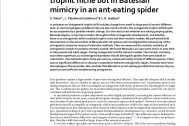Obsah
In predators an ontogenetic trophic shift includes change from small to large prey of several different taxa. In myrmecophagous predators that are also mimics of ants, the ontogenetic trophic shift should be accompanied by a parallel mimetic change. Our aim was to test whether ant-eating jumping spider, Mexcala elegans, is myrmecomorphic throughout their ontogenetic development, and whether there is an ontogenetic shift in realised trophic niche and their mimetic models. We performed field observations on the association of Mexcala with ant species and investigated the natural prey of the ontogenetic classes by means of molecular methods. Then we measured the mimetic similarity of ontogenetic morphs to putative mimetic models. We found Mexcala is an inaccurate mimic of ants both in the juvenile and adult stages. During ontogenesis it shifts mimetic models. The mimetic similarity was rather superficial, so an average bird predator should distinguish spiders from ants based on colouration. The realised trophic niche was narrow, composed mainly of ants of different species. There was no significant difference in the prey composition between ontogenetic stages. Females were more stenophagous than juveniles. We conclude that Mexcala is an ant-eating specialist that reduces its prey spectrum and shifts ant models during ontogenesis.



